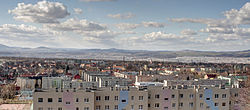| Upper Lusatia Oberlausitz | |
 Bogatynia panorama Bogatynia panorama | |
| Arms | |
 | |
| Information | |
| Country | Poland, Germany |
| Capital city | Bautzen |
| Surface | approx. 8,000 km² |
| Population | approx. 800,000 |
| Tongue | Polish, German, Upper Sorbian |
Upper Lusatia (not M. Oberlausitz) - a region located in Germany and in Poland. The main city and historical capital of the region is Bautzen. The largest city of Lusatia is Görlitz (Zgorzelec).
The Upper Lusatian language developed in these lands and is now spoken by several percent of the inhabitants.
The area between the rivers Nysa Łużycka and Kwisa belongs to Poland, and the area to the west of the Nysa Łużycka belongs to Germany.
Tourism
A characteristic feature of Upper Lusatia is the presence of numerous so-called half-timbered houses, i.e. half-timbered structures. The largest Polish city in its territory - Zgorzelec is an unusual city, as until 1945, together with the neighboring Görlitz, it constituted one urban organism divided by the Nysa Łużycka, which has been a border river since then. As a result of this division, most of the Old Town buildings, incl. with the market square and the town hall, she remained on the German side. In the last 20 years, thanks to huge cash inflows, Görlitz has gained a new splendor and is today called by many the most beautiful city in Germany. The biggest attraction in Zgorzelec is the Art Nouveau building of the Municipal Cultural Center. Other Upper Lusatian towns include Lubań - a city with a perceptible medieval atmosphere, as well as German Zittau, Löbau or Bautzen, where you can hear a relic of the language of the first Slavic settlers - the Sorbian, this is where the Sorbs live with the statute of a national minority, and road signs are in bilingual names. In Bautzen and its vicinity, the Sorbian community has about 40,000 inhabitants, but this number is systematically decreasing.
Worth seeing
Polish side
- Zgorzelec - building of the Municipal Cultural Center, Lusatian Museum, Jakub Böhme House, Nysa Suburb, military cemetery;
- Lubań - Bracka Tower, market square, distance pole, city walls;
- Bogatynia - half-timbered houses, a viewpoint over the opencast of the "Turów" mine;
- Białogóra - Old Slavic burial mounds from the 9th century;
- Żarki on the Neisse River - a reservoir and a historic Evangelical church.
German side
- Bautzen - the old town, the Sorbian Museum, the Baroque town hall, the two-denominational cathedral from the 13th century, the Old Waterworks from the 16th century, the Gothic castle of Ortenburg, the leaning tower;
- Görlitz - renovated old town, market square, town hall from the 14th century, church of St. Peter and Paul, a copy of the Holy Sepulcher, city towers, the Arch of S zeptów, the Town Hall Pharmacy;
- Löbau - the highest cast iron tower in Europe, distance poles;
- Marienthal - baroque Cistercian abbey, the oldest female order in Germany - from the 13th century;
- Zittau - Lenten curtain from the 15th century, town hall, old town;
- Oybin - a picturesque spa in the Zittau Mountains National Park, ruins of a castle and monastery from the 14th century, narrow-gauge railway;
- Jonsdorf - health resort, Butterfly House, narrow-gauge railway;
- Bad Muskau - Muskauer Park entered on the UNESCO list, castle from the 16th century, narrow-gauge railway;
- Kleinwelka - Dinosaur Park, adventure labyrinth;
- Herrnhut - a place founded in the 18th century as a refugee for religious refugees (Moravian brothers), church, urban layout, Ethnographic Museum
- Rammenau - baroque palace from the 18th century;
- Taubenheim - 25 sundials;
- Obercunnersdorf - one of the most beautiful villages in Germany, over 250 half-timbered houses, a wooden windmill;
- Kromlau - rhododendron park;
- Pulsnitz - Gingerbread Museum.

